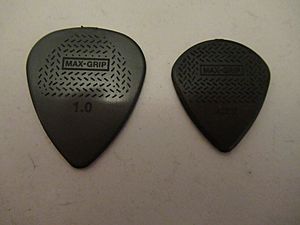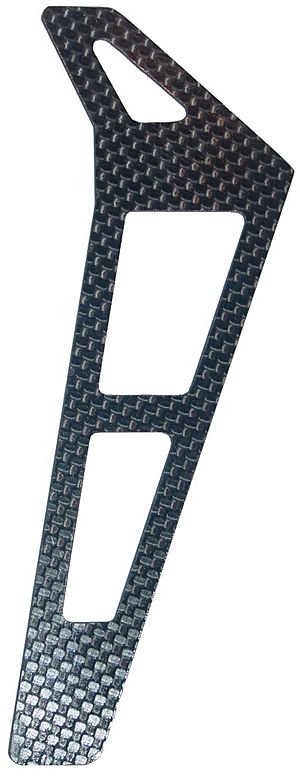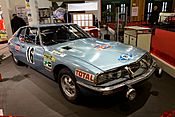Carbon-fiber-reinforced polymers facts for kids
Carbon fiber-reinforced polymers (often called CFRPs or just carbon fiber) are super strong and very light plastics. They are made with tiny carbon fibers woven together. Think of them like super-strong fabric mixed with glue.
CFRPs can be expensive to make. But they are used when things need to be very strong and light. You can find them in airplanes, fast cars, sports equipment, and even some buildings.
The "glue" that holds the carbon fibers together is usually a type of plastic called epoxy. Other plastics like polyester or nylon can also be used. Sometimes, special things like silica gel or carbon nanotubes are added to make the material even better.
Contents
What are Carbon Fiber Composites?
CFRPs are a type of composite material. This means they are made from two main parts: a "matrix" (the glue) and a "reinforcement" (the carbon fibers).
The carbon fibers give CFRPs their amazing strength and stiffness. The plastic matrix holds all these fibers together. Because CFRPs have two different parts, their properties depend on both.
Strength and Stiffness
Carbon fibers make CFRPs very strong and stiff. Unlike materials like steel or aluminum, CFRPs are not equally strong in all directions. Their strength depends on how the carbon fibers are laid out. If the fibers are lined up in one direction, the material will be strongest in that direction.
Engineers use special math to figure out how strong and stiff a CFRP will be. They consider how many carbon fibers are used and how they are arranged.
Toughness and Breaking
Most CFRPs made with epoxy are very stiff but can break suddenly without much warning. This is because they don't bend or stretch much before breaking. Scientists are working on new types of CFRPs that are tougher and can handle more stress before breaking. One promising material is called PEEK, which is much tougher but also harder to work with and more expensive.
Fatigue and Wear
Unlike metals, CFRPs don't have a clear "fatigue limit." This means that even small stresses repeated many times can eventually cause them to break. Engineers have to be very careful when designing things like airplane parts with CFRPs to make sure they are extra strong.
Environmental Effects
CFRPs are great at resisting rust (corrosion). However, things like heat and moisture can affect them. Water can make the plastic "glue" softer, which can weaken the material, especially where the fibers and plastic meet. That's why parts like airplane fan blades are designed to resist jet fuel, oil, and rain. Paint is also used to protect them from sunlight.
Another thing to know is that carbon fibers can cause galvanic corrosion if they touch certain metals like aluminum or mild steel. This means the metal can start to rust faster.
CFRPs are also very hard to cut or shape with tools. This can wear out tools quickly.
How are Carbon Fiber Composites Made?
The main part of a CFRP is a carbon filament. This filament is made from a special material, often a type of plastic called polyacrylonitrile (PAN).
First, the PAN is spun into thin threads, like making yarn. Then, these threads are heated to very high temperatures. This process removes all the non-carbon atoms, leaving behind pure carbon fibers. These fibers are then wound onto spools.
Making Sheets
From these fibers, a flat sheet can be made. These sheets can be layered on top of each other in different directions (like 0°, +60°, or -60°). This layering helps make the final product strong in many directions.
Sometimes, the fibers are woven into a fabric, like a twill pattern. The way CFRP parts are made depends on what the final product will be, how shiny it needs to be, and how many will be made.
Molding Methods
Many CFRP parts are made by putting layers of carbon fiber fabric into a mold. The mold is shaped like the final product.
- Wet Layup: In this method, the plastic "glue" (epoxy) is mixed and painted onto the fabric layers in the mold. Then, the mold is heated or left to air-cure. This makes a strong, stiff, and rust-resistant part.
- Pre-preg: For high-performance parts, the carbon fiber fabric might already have the epoxy mixed into it. This is called "pre-preg." These parts are often put into a vacuum bag and heated in a special oven called an autoclave. This removes any tiny air bubbles that could weaken the part.
- Vacuum Bagging: For simpler parts, a vacuum bag can be used. The fabric and resin are placed in a mold, and then a vacuum bag is sealed around it. Air is sucked out, which presses the fabric and resin together while it hardens.
- Compression Molding: This is a faster way to make CFRP parts. Two molds (a male and a female part) are pressed together with the fabric and resin inside. This method is quick, but the molds are very expensive to make.
- Filament Winding: For complex shapes, a machine can wind carbon fiber filaments around a core or a mold.
What are Carbon Fiber Composites Used For?
Aerospace Engineering

CFRPs are used a lot in airplanes because they are so light and strong. For example, the Airbus A350 XWB is made of 52% CFRPs, including parts of the wings and body. The Boeing 787 Dreamliner also uses a lot of CFRPs (50%).
The Airbus A380 was one of the first big passenger planes to have a central wing part made of CFRP. Using these new materials can sometimes cause delays in making planes because the manufacturing processes are still quite new.
In 1968, a fan part made of carbon fiber was used in a Rolls-Royce Conway engine on a Vickers VC10 airplane.
Specialized aircraft makers like Scaled Composites use CFRPs a lot. They even used them in the first private spacecraft, Spaceship One. Small micro air vehicles (drones) also use CFRPs because they need to be very light.
Automotive Engineering
CFRPs are very popular in high-end race cars. Their high cost is worth it because being light is super important for speed. Race car builders can even design carbon fiber parts to be strong in specific directions where they need to handle a lot of force.
The first Formula One car with a carbon fiber body (called a monocoque chassis) was introduced by McLaren in 1981. This made the car much stiffer and safer. Many supercars today use CFRPs for their main body and other parts.
Even back in 1971, the Citroën SM car had optional lightweight carbon fiber wheels. Smaller car makers often use CFRPs for body panels on their high-end cars because it's stronger and lighter than other plastics.
Civil Engineering
CFRPs are becoming important in building and construction. They are used to make existing structures stronger or as a new material instead of steel.
- Strengthening Old Buildings: CFRPs are often used to strengthen old bridges or buildings that need to hold more weight than they were designed for. This is cheaper than replacing the whole structure.
- Earthquake Protection: Wrapping columns with CFRPs can make them much stronger and more flexible during an earthquake. This is a common way to protect buildings in earthquake zones.
- Water Pipes: CFRPs are also used to line large water pipes. This helps prevent the pipes from breaking and keeps them working for a long time.
While CFRPs are more expensive than other materials like fiberglass, they have better properties. Scientists are still researching how to use them more widely in construction.
Carbon-Fiber Microelectrodes
Tiny carbon fibers are used to make very small tools called microelectrodes. These are used in science to detect chemical signals, especially in the brain.
Sports Goods

CFRPs are widely used in sports equipment. You can find them in:
- Racquets for squash, tennis, and badminton.
- Hockey sticks and fishing rods.
- Surfboards and high-end swim fins.
- Running blades for amputee athletes like Jonnie Peacock.
- Some basketball shoes use carbon fiber plates to keep the foot stable.
In 2006, some cricket bats had a thin carbon fiber layer. This was supposed to make them last longer, but it was banned in 2007 by the ICC.
Bicycles
A bicycle frame made of CFRP is much lighter than one made of steel, aluminum, or titanium. The way the carbon fibers are woven can be designed to make the bike stiffer in certain areas. This means bikes can be tuned for different riding styles, like stiff frames for sprinting or more flexible ones for long rides.
CFRPs are also used in other bike parts like forks, handlebars, seatposts, and crank arms. Even rims are made of CFRP, making them lighter and more stable. While strong and light, CFRP bike parts can crack if hit hard or installed incorrectly, and they can be difficult to repair.
Other Applications

CFRPs are used in many other high-end products that need to be stiff and light:
- Musical instruments like violin bows, guitar parts, and even entire cellos or guitars.
- Some firearms use CFRPs to replace metal or wood parts.
- High-performance drone bodies and parts for remote-controlled vehicles.
- Lightweight poles for tripods, tents, fishing, and window cleaning.
- In dentistry, carbon fiber posts are used to fix teeth after a root canal.
- Train bogies (the wheel assembly) for passenger trains, making them lighter and saving energy.
- Laptop cases and other strong, light cases.
- Archery equipment like arrows and crossbow parts.
- As a material for 3D printing strong, lightweight tools.
Disposal and Recycling
CFRPs last a long time, especially if kept out of the sun. But when it's time to get rid of them, they can't be melted down like metals.
If they don't contain certain plastics, CFRPs can be broken down by heating them in an environment without oxygen. This can help reclaim the carbon fibers and other materials.
CFRPs can also be shredded or milled at low temperatures to get the carbon fibers back. However, this process makes the fibers shorter, so the recycled material is not as strong as the original. Still, these shorter fibers can be used in other products, like laptop cases, where extreme strength isn't needed.
Carbon Nanotube Reinforced Polymer (CNRP)
In 2009, a new material called carbon nanotube reinforced polymer (CNRP) was introduced. It's even stronger and tougher than regular CFRPs.
CNRP still uses carbon fiber as the main reinforcement. But the "glue" that holds it together is an epoxy mixed with tiny carbon nanotubes. This material is used in aircraft like the Lockheed Martin F-35 Lightning II.
See also
 In Spanish: Polímero reforzado con fibra de carbono para niños
In Spanish: Polímero reforzado con fibra de carbono para niños
- Carbon fibers
- Composite repair
- Mechanics of Oscar Pistorius's running blades
- Reinforced carbon–carbon
- Forged carbon fiber
- Carbon-ceramic
- Carbotanium





